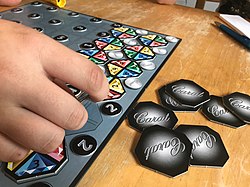Carat (game)
| Carat | |
|---|---|
 Carat , game situation |
|
| Game data | |
| author | Dirk Henn |
| graphic | Christian Bohr , Jo Hartwig |
| publishing company | db games , queen games |
| Publishing year | 1993, 1998 |
| Art | Board game |
| Teammates | 2 to 4 |
| Duration | about 40 minutes |
| Age | from 10 |
Carat is an abstract board game by the German game designer Dirk Henn . The game first appeared in 1993 as a simple handcrafted version by its self-published db-Spiele and was published in 1998 in a new version by Queen Games . The game is a placement game in which tiles with diamonds of different colors have to be placed on a game board in order to get points for their own color.
In 2004 the game The Gardens of the Alhambra was released , which is based on the same game mechanics. Thematically and visually, however, the game is based on the successful game Alhambra , which also comes from Dirk Henn and was published by Queen Games.
Theme and equipment
In the game, the players try to get as many points as possible on a game board with the help of diamond tiles by moving point fields with the diamonds of their color. Since all diamond tiles show diamonds with all four colors, the players always generate points for their opponents when they are placed. The winner of the game is the player who has the most points at the end.
In addition to instructions, the game material consists of:
- a game board as a storage area with a grid for the point chips and the game pieces,
- 49 point chips with the numerical values 1 to 5 (ten times the values 1 to 4, only nine times the value 5),
- 36 game pieces (diamond tiles), each with four diamonds in the four player colors and values from 1 to 6 for each of these pieces,
- a writing pad to write down the points.
Style of play
Before the game, the game board is set up in the middle of the table. The point chips are shuffled and placed face up by the players on the round scoring fields on the game board. Then each player chooses a player color, if there are fewer than four players, the other colors are neutral. The diamond tiles are shuffled face down and placed next to the game board as a supply, each player draws a starting tile and takes it in hand.
Starting with a starting player, the game is played clockwise. The active player places his or her diamond tile on a free space on the grid of the game board, with each individual diamond adjacent to a scoring stone. Then he takes a new tile from the supply and puts it in his hand. The starting player may start as he likes, but he may not occupy a field on the edge of the field or in the corner. Each additional token must be placed on any tile that is already on display. If a player completely encloses a scoring stone with a tile, a scoring takes place and the scoring stone is turned over.
All diamonds on the point chip on display are taken into account in the evaluation. If a player alone has the highest sum of the adjoining diamond values, that player receives the points for that chip. If several players have the same values, the next player receives the points whose value is not identical to that of another player. If all four players or two players have the same values, the points are not awarded. To determine the number of points, the value of the point chip is multiplied by the number of different colors of the adjacent diamonds.
The game ends when all the game pieces have been placed on the playing field and the playing field is completely filled. The player with the highest number of points wins the game.
variants
The Carat rules of the game state two variants:
- In a game with two players, both players can play with two colors each, which are scored independently of each other.
- For a more tactical game, all players can start with three diamond tiles and move back up to three tiles on each move after discarding them.
History and reception
The game Carat was developed by Dirk Henn and published by him in 1993 as a simple hand-made version in the self-published db-Spiele by him and his wife Barbara Henn. In 1998, Queen Games published the game in Germany. In 2004, based on Carat, the game The Gardens of the Alhambra was released with the same game mechanics, but the theme was based on the successful and award-winning game Alhambra by Dirk Henn, which was also published by Queen Games.
2005 Queen Games published The gardens of Alhambra in addition under the English title The Gardens of the Alhambra in an international and multilingual version. The gardens of Alhambra was in the 2005 recommendation list of the game of the year received.
supporting documents
- ↑ a b c d e f Carat , game instructions 1st edition Queen Games, 1998.
- ↑ The Gardens of the Alhambra , versions by Carat and successors at BoardGameGeek. Retrieved July 5, 2018 .
- ↑ The gardens of the Alhambra in the database of the Spiel des Jahres eV; accessed on July 6, 2018.
Web links
- Carat (db games) in the Luding games database
- Carat (Queen Games) in the Luding games database
- The Gardens of the Alhambra in the game database BoardGameGeek (English)
- Carsten Wesel: Carat on FAIRspielt, accessed on July 6, 2018.

